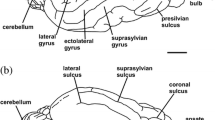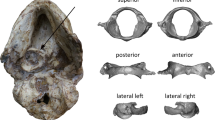Abstract
The oldest felid specimen in the New World is a cranium from Ginn Quarry, Nebraska. We present a detailed description of the external brain anatomy of this specimen as inferred from its cranial endocast. Compared with modern felids, the Ginn Quarry specimen has a dorsoventrally lower cerebrum, with only three major sulci and a laterally narrower frontal lobe. The cerebellum is exposed to a large extent, and the posterior cerebellar vermis is straight rather than twisted as in modern felids. The shape of its cerebrum and the cortical sulcal pattern are similar to those of Proailurus and Hyperailurictis. The encephalization of the Ginn Quarry felid is the same as that of Hyperailurictis and slightly smaller than in Proailurus. The degree of cortical folding is intermediate between the conditions seen in Proailurus and Hyperailurictis. The Ginn Quarry felid differs from Proailurus in having a better developed frontal lobe, a shorter cerebellum and slightly longer peduncles. Based on brain anatomy, we suggest that the Ginn Quarry felid should not be dismissed as a ‘proailurine-grade’ felid. Instead, it should be either considered a primitive form of Hyperailurictis or assigned to a new genus.





Similar content being viewed by others
References
Antón, M., M.J. Salesa, and G. Siliceo. 2013. Machairodont adaptations and affinities of the Holarctic late Miocene homotherin Machairodus (Mammalia, Carnivora, Felidae): the case of Machairodus catocopis Cope, 1887. Journal of Vertebrate Paleontology 33(5): 1202–1213.
Benoit, J. 2015. A new method of estimating brain mass through cranial capacity in extinct proboscideans to account for the non-neural tissues surrounding their brain. Journal of Vertebrate Paleontology 35: e991021.
Connolly, C.J. 1950. External morphology of the primate brain. Illinois: CC Thomas.
Cuff, A.R., C. Stockey, and A. Goswami. 2017. Endocranial morphology of the extinct North American lion (Panthera atrox). Brain, Behavior and Evolution 88(3–4): 213–221.
Finarelli, J.A., and J.J. Flynn. 2009. Brain-size evolution and sociality in Carnivora. Proceedings of the National academy of Sciences of the United States of America 106(23): 9345–9349.
Galusha, T. 1975. Stratigraphy of the Box Butte Formation, Nebraska. Bulletin of the American Museum of Natural History 156(1): 1–68.
Gervais, P. 1870. Mémoire sur les formes cérébrales propres aux Carnivores vivants et fossiles. Nouvelles Archives du Muséum d’Histoire Naturelle de Paris 6: 103–162.
Haight, J.R., and P.F. Murray. 1981. The cranial endocast of the Early Miocene marsupial, Wynyardia bassiana: an assessment of taxonomic relationships based upon comparisons with recent forms. Brain, Behavior and Evolution 19: 17–36.
Hunt Jr., R.M. 1998. Evolution of the aeluroid carnivora: diversity of the earliest aeluroids from Eurasia (Quercy, Hsanda-Gol) and the origin of felids. American Museum Novitates 3262: 1–65.
Iurino, D.A., A. Profico, M. Cherin, A. Veneziano, L. Costeur, and L. Sardella. 2015. A lynx natural brain endocast from Ingarano (Southern Italy; Late Pleistocene): taphonomic, morphometric and phylogenetic approaches. Hystrix (The Italian Journal of Zoology) 26(2): 110–117.
Ivanoff, D.V., M. Wolsan, and A. Marciszak. 2014. Brainy stuff of long-gone dogs: a reappraisal of the supposed Canis endocranial cast from the Pliocene of Poland. Naturwissenschaften 101(8): 645–651.
Jerison, H.J. 1973. Evolution of the brain and intelligence. New York: Academic Press.
Jerison, H.J. 2012. Digitized fossil brains: neocorticalization. Biolinguistics 6: 383–392.
Johnson, W.E., E. Eizirik, J. Pecon-Slattery, W.J. Murphy, A. Antunes, E. Teeling, and S.J. O’Brien. 2006. The Late Miocene radiation of modern Felidae: a genetic assessment. Science 311(5757): 73–77.
Kretzoi, M. 1929. Materialien zur phylogenetischen Klassifikation der Aeluroïdeen. X:e Congrès International de Zoologie 1929: 1293–1355.
Lyras, G.A. 2009. The evolution of the brain in Canidae (Mammalia: Carnivora). Scripta Geologica 139: 1–93.
Lyras, G.A., and A.A.E. van der Geer. 2003. External brain anatomy in relation to phylogeny of Caninae (Carnivora: Canidae). Zoological Journal of the Linnean Society 138: 505–522.
Lyras, G.A., A. Giannakopoulou, M. Kouvari, and G.C. Papadopoulos. 2017. Evolution of gyrification in carnivores. Brain, Behavior and Evolution 88(3–4): 187–203.
Macrini, T.E., G.W. Rougier, and T. Rowe. 2007a. Description of a cranial endocast from the fossil mammal Vincelestes neuquenianus (Theriiformes) and its relevance to the evolution of endocranial characters in therians. The Anatomical Record 290: 875–892.
Macrini, T.E., C. Muizon, R.L. Cifelli, and T. Rowe. 2007b. Digital cranial endocast of Pucadelphys andinus, a Paleocene metatherian. Journal of Vertebrate Paleontology 27: 99–107.
Manger, P.R. 2006. An examination of cetacean brain structure with a novel hypothesis correlating thermogenesis to the evolution of a big brain. Biological Reviews 81: 293–338.
Marino, L. 1999. Brain growth in the harbor porpoise and Pacific white-sided dolphin. Journal of Mammalogy 80: 1353–1360.
Oboussier, H. 1972. Evolution of the mammalian brain: some evidence on the phylogeny of the antelope species. Acta Anatomica 83: 70–80.
O’Higgins, P., and N. Jones. 1998. Facial growth in Cercocebus torquatus: an application of three-dimensional geometric morphometric techniques to the study of morphological variation. Journal of Anatomy 193: 251–272.
Radinsky, L.B. 1968. A new approach to mammalian cranial analysis, illustrated by examples of prosimian primates. Journal of Morphology 124: 167–180.
Radinsky, L.B. 1969. Outlines of canid and felid brain evolution. Annals of the New York Academy of Sciences 167: 277–288.
Radinsky, L.B. 1973a. Are stink badgers skunks? Implications of neuroanatomy for mustelid phylogeny. Journal of Mammalogy 54 (3): 585–593.
Radinsky, L.B. 1973b. Evolution of the canid brain. Brain, Behavior and Evolution 7: 169–202.
Radinsky, L.B. 1975a. Evolution of the felid brain. Brain, Behavior and Evolution 11: 214–254.
Radinsky, L.B. 1975b. Viverrid neuroanatomy: phylogenetic and behavioral implications. Journal of Mammalogy 56: 130–150.
Radinsky, L.B. 1978. The evolutionary history of cat brains. Museologia 11(7): 35–41.
Rothwell, T.M. 2003. Phylogenetic systematics of North American Pseudaelurus (Carnivora: Felidae). American Museum Novitates 3403: 1–64.
Sakai, S.T., B.M. Arsznov, A.E. Hristova, E.J. Yoon, and B.L. Lundrigan. 2016. Big cat coalitions: a comparative analysis of regional brain volumes in Felidae. Frontiers in Neuroanatomy 10: 99. https://doi.org/10.3389/fnana.2016.00099.
Sakamoto, M., and M. Ruta. 2012. Convergence and divergence in the evolution of cat skulls: temporal and spatial patterns of morphological diversity. PLoS One 7(7): e39752.
Salesa, M.J., M. Antón, J. Morales, and S. Peigné. 2011. Functional anatomy of the postcranial skeleton of Styriofelis lorteti (Carnivora, Felidae, Felinae) from the Middle Miocene (MN 6) locality of Sansan (Gers, France). Estudios Geológicos 67(2): 223–243.
Van Valkenburgh, B. 1990. Skeletal and dental predictors of body mass in carnivores. In Body size in mammalian paleobiology: estimation and biological implications, eds. J. Damuth and B.J. MacFadden, 181–206. New York: Cambridge University Press.
Werdelin, L., N. Yamaguchi, W.E. Johnson, and S.J. O’Brien. 2010. Phylogeny and evolution of cats (Felidae). In The biology and conservation of wild felids, eds. D.M. Macdonald and A. Loveridge, 59–82. Oxford: Oxford University Press.
Willemsen, G.F. 1980. Comparative study of the functional morphology of some Lutrinae, especially Lutra lutra, Lutrogale perspicillata and the Pleistocene Isolalutra cretensis. Proceedings of the Koniklijke Nederlandse Akademie van Wetenschappen (Series B) 83(3): 289–326.
Acknowledgements
We thank Larry Heaney, William Simpson, the late William Stanley (Field Museum of Natural History, Chicago, IL, USA), John Flynn, Jin Meng, Judy Galkin (American Museum of Natural History, New York, USA) and Christine Argot (Muséum national d’Histoire naturelle, Paris, France) for providing us access to collections under their charge. We thank Thomas Rothwell (Paris Hill Cat Hospital, New York) for the fruitful discussions we had with him and Miranta Kouvari and Bartholomeus van der Geer for scanning the endocasts. We thank the reviewers, Julien Benoit and Thomas Macrini, for the critical changes and corrections they made on the manuscript. We also thank the Associate Editor, Irina Ruf, and the Editor-in-chief, Mike Reich, for their comments on the paper.
Author information
Authors and Affiliations
Corresponding author
Additional information
Handling Editor: Irina Ruf.
Rights and permissions
About this article
Cite this article
Lyras, G.A., Giannakopoulou, A. & Werdelin, L. The brain anatomy of an early Miocene felid from Ginn Quarry (Nebraska, USA). PalZ 93, 345–355 (2019). https://doi.org/10.1007/s12542-018-00444-9
Received:
Accepted:
Published:
Issue Date:
DOI: https://doi.org/10.1007/s12542-018-00444-9





